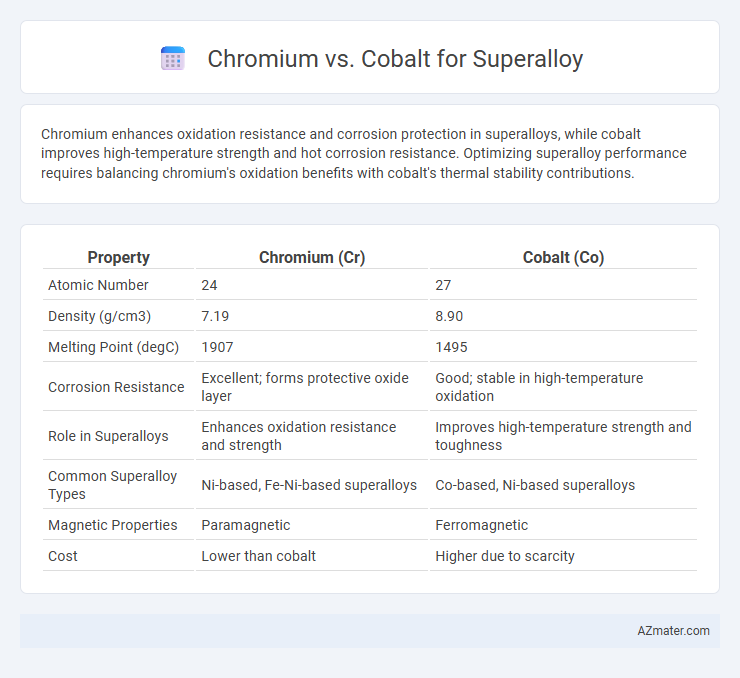Chromium enhances oxidation resistance and corrosion protection in superalloys, while cobalt improves high-temperature strength and hot corrosion resistance. Optimizing superalloy performance requires balancing chromium's oxidation benefits with cobalt's thermal stability contributions.
Table of Comparison
| Property | Chromium (Cr) | Cobalt (Co) |
|---|---|---|
| Atomic Number | 24 | 27 |
| Density (g/cm3) | 7.19 | 8.90 |
| Melting Point (degC) | 1907 | 1495 |
| Corrosion Resistance | Excellent; forms protective oxide layer | Good; stable in high-temperature oxidation |
| Role in Superalloys | Enhances oxidation resistance and strength | Improves high-temperature strength and toughness |
| Common Superalloy Types | Ni-based, Fe-Ni-based superalloys | Co-based, Ni-based superalloys |
| Magnetic Properties | Paramagnetic | Ferromagnetic |
| Cost | Lower than cobalt | Higher due to scarcity |
Introduction to Superalloys
Superalloys are high-performance alloys known for their exceptional strength, corrosion resistance, and ability to maintain stability under extreme temperatures. Chromium and cobalt are essential elements in the composition of superalloys, each contributing distinct properties: chromium enhances oxidation and corrosion resistance, while cobalt improves high-temperature strength and phase stability. Understanding the roles of chromium and cobalt helps optimize superalloy performance in demanding applications such as aerospace turbine engines and power generation.
Overview of Chromium and Cobalt
Chromium is a key element in superalloys known for its exceptional corrosion resistance, oxidation protection, and ability to form a stable oxide layer at high temperatures. Cobalt offers superior mechanical strength, excellent thermal stability, and enhanced wear resistance, making it ideal for high-stress applications in turbine engines. Both elements play crucial roles in improving the overall performance and durability of superalloys under extreme operating conditions.
Chemical Properties Comparison
Chromium exhibits high corrosion resistance and forms a stable oxide layer, enhancing the oxidation resistance of superalloys, whereas cobalt contributes superior strength and toughness at elevated temperatures due to its stable face-centered cubic (FCC) crystal structure. Chromium's chemical reactivity enables the formation of carbides that improve creep resistance, while cobalt's lower chemical affinity for carbides results in different microstructural stability. The distinct chemical bonding and oxidation behaviors of chromium and cobalt critically influence the thermal stability and mechanical performance of superalloys in high-temperature environments.
Role in High-Temperature Performance
Chromium enhances corrosion and oxidation resistance in superalloys by forming a stable oxide layer, maintaining structural integrity at high temperatures typically above 900degC. Cobalt significantly improves high-temperature strength and phase stability, especially in the matrix of nickel-based superalloys, allowing operation up to approximately 1100degC. The synergy of chromium and cobalt balances oxidation resistance with mechanical strength, optimizing superalloy performance in extreme aerospace and power generation environments.
Oxidation and Corrosion Resistance
Chromium enhances oxidation resistance in superalloys by forming a stable, adherent oxide layer, primarily chromium oxide, which protects the underlying metal from high-temperature oxidation and corrosion. Cobalt contributes to corrosion resistance by improving the alloy's overall stability and resistance to hot corrosion, especially in aggressive environments containing sulfur and halides. Superalloys combining high chromium and cobalt contents exhibit superior resistance to oxidative degradation and corrosive attacks, essential for aerospace and power generation applications.
Impact on Mechanical Strength
Chromium enhances mechanical strength in superalloys by promoting the formation of a stable, protective oxide layer and improving creep resistance, crucial for high-temperature applications. Cobalt contributes to solid solution strengthening and increases phase stability, which significantly boosts yield strength and fatigue resistance under extreme thermal and mechanical stress. The combined use of chromium and cobalt in superalloy formulations offers a balanced improvement in mechanical strength, optimizing performance in aerospace and power generation components.
Influence on Alloy Microstructure
Chromium enhances the microstructure of superalloys by promoting the formation of a stable, continuous oxide scale that improves oxidation resistance and contributes to the development of a protective oxide layer along grain boundaries. Cobalt influences the microstructure by stabilizing the gamma prime (g') phase, which is crucial for high-temperature strength and creep resistance, and can alter the solid solution strengthening of the matrix. The combined presence of chromium and cobalt tailors phase stability, grain boundary character, and precipitation behavior, optimizing the alloy's performance under extreme thermal and mechanical conditions.
Cost and Availability Factors
Chromium is more abundant and cost-effective than cobalt, making it a preferred choice in superalloy production for applications requiring large-scale manufacturing. Cobalt, although more expensive and less abundant, offers superior high-temperature strength and corrosion resistance, justifying its use in critical aerospace and gas turbine components. The cost-performance balance heavily influences material selection, with chromium favored for budget-sensitive projects and cobalt reserved for high-performance demands.
Industrial Applications of Chromium- and Cobalt-Based Superalloys
Chromium-based superalloys exhibit excellent oxidation resistance and corrosion resistance, making them ideal for high-temperature applications in gas turbines and jet engines. Cobalt-based superalloys offer superior strength and hot corrosion resistance, which are critical in aerospace, power generation, and chemical processing industries. Both materials are pivotal in manufacturing turbine blades, combustion chambers, and heat exchangers, where durability and performance at extreme temperatures are essential.
Future Trends in Superalloy Development
Chromium and cobalt remain critical elements in superalloy development due to their exceptional high-temperature strength and corrosion resistance. Future trends prioritize increasing the chromium content to enhance oxidation resistance while optimizing cobalt levels to improve hot corrosion performance and mechanical properties. Advances in additive manufacturing and alloy design focus on balancing these elements to develop superalloys with improved durability, thermal stability, and reduced environmental impact in aerospace and power generation applications.

Infographic: Chromium vs Cobalt for Superalloy
 azmater.com
azmater.com